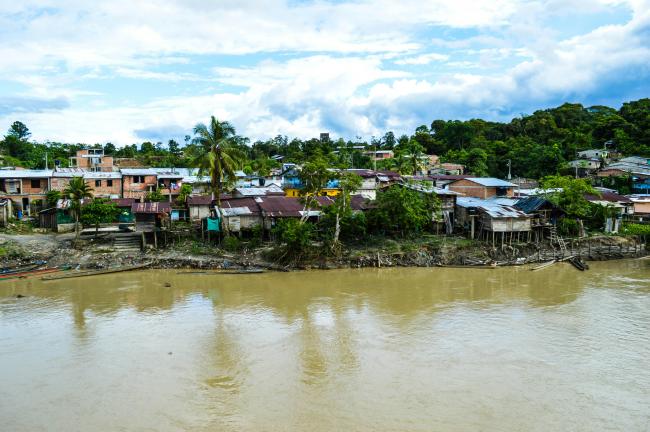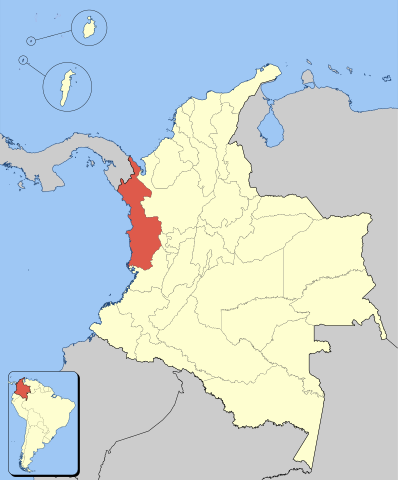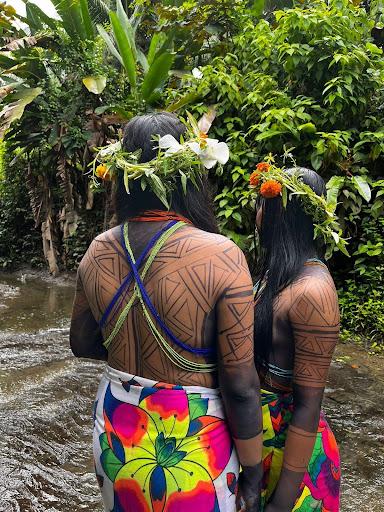
Leer este artículo en español.
“Since we were children, we were taught to conserve and preserve nature,” recounts Sofía Rivas, “but displacement forced us to leave our land, to save our lives.” Rivas is a sabedora, a traditional knowledge holder and nurse from Colombia’s Chocó department, on the northwestern Pacific coast. Her father taught her to practice medicine, passing down knowledge learned over generations. She was raised to care for the environment, the source of her treatments. If one tree was cut down, her community planted three to replace it.
While treating wounds of those injured by the war in 1998, Rivas was kidnapped by an armed group and forced to treat their soldiers. She fled to Bogotá, losing contact with her loved ones and her connection with her territory in the process. Displaced from her land and family, Rivas continued to work as a midwife and as an activist for displaced Afro-Colombian women in the capital city. Upon returning to Chocó decades later, Rivas found that the territory she once knew had changed. Extractive industries like gold mining had razed the trees, polluted the rivers, and left holes in the Earth. “The environment is a sad environment,” she says, remembering her return. “You are left feeling that the land is screaming at you.”
Displacement, as Rivas’s story illustrates, marks a rupture between the land and its ancestral inhabitants. This rupture harms not only those forced to leave, but also the land and the biodiversity it holds. Although humanity’s impact on the environment is largely conceptualized as harmful, a harbinger of extraction and contamination, this perspective negates the positive impact of humans who live in harmony with their local environment by protecting and promoting biodiversity. In Colombia—the world’s second most biodiverse nation—there are 102 Indigenous groups, 4.7 million Afro-Colombian people, and countless rural farmers who leverage their ancestral knowledge to support ecosystem health.
The site of the Western Hemisphere’s longest running civil war, Colombia suffers from one of the world’s most acute crises of conflict-related internal displacement. Of the more than nine million people who are registered victims of the conflict, nearly half are internally displaced. In the years following the 2016 Peace Accords with the Revolutionary Armed Forces of Colombia (FARC), rates of displacement have not abated. In 2022, over 300,000 new conflict-related displacements were reported, the highest number recorded since the Internal Displacement Monitoring Centre began tracking data. Chocó is at the center of this crisis: as of 2023, the region accounts for 16.8 percent of Colombians affected by mass displacement. Afro-Colombian and Indigenous communities, who comprise the vast majority of Chocó’s population, are disproportionately affected.
In this region, the war remains omnipresent. The National Liberation Army (ELN), Latin America’s last remaining Marxist guerilla group, maintains a stronghold in the department alongside other armed groups such as the Gaitanista Self-Defense Forces of Colombia (AGC, often called the Clan del Golfo). Armed groups in Chocó have increasingly resorted to confinement as an alternative to displacement to exercise control over territory. Confinement is the forceful containment of a population within a restricted area, a tactic that is prevalent in Chocó: 56.4 percent of Colombians affected by confinement live in the department.
Like displacement, confinement creates a rupture between person and place that harms the land. Jafeth Leyes, a resident of northern Chocó, describes confinement as being forced to “remain static,” meaning that “people can’t plant and can’t interact with the territory in an active way. They can’t engage in their daily ancestral activities.” This inability to carry out everyday activities has an environmental impact. For example, ancestral seeds and diverse plant varieties are lost when communities are prevented from caring for their seed banks.
When the protectors of biodiversity cannot steward their territories, extractive industries and/or armed groups—both key drivers of the armed conflict—fill the vacuum. Traditional knowledge is lost, and ecosystems suffer.

Strategies of Territorial Control in Chocó
Chocó is part of a biogeographical region spanning from Panamá to Ecuador that contains the highest concentration of biodiversity in the world. Rich in natural resources, its dense rainforests, river networks, lumber trees, arable land, and gold deposits make Chocó vulnerable to illicit crop cultivation, drug smuggling, and extractive industries.
The struggle to control territory is foundational to the violence of the Colombian civil war. Displacement is the result of this competition. The forced removal of the land’s ancestral occupants facilitates access for both armed groups and the agro-industrial sector, with paramilitary groups often profiting from forcibly displacing people from their land. The Colombian Constitutional Court affirmed the statement, made by an Afro-Colombian organization, that “the objective of the violence is to remove people from their land, and therefore create a space for megaprojects.”
Land grabbing encapsulates the interwoven processes of forced displacement and capital accumulation. Multinational companies in Chocó convert sacred territory into “sacrifice zones,” in which land is pillaged by extractive industries and benefits flow to multinational corporations in the Global North. In 2016, the passage of Law 1776 known as ZIDRES (Zonas de Interés de Desarrollo Rural, Económico y Social) created rural economic and social development zones to “encourage exploitation of current unproductive areas” and internationalize the economy. In Chocó, ZIDRES encouraged mass land grabs for agro-industrial development projects at the cost of pending land restitution claims filed by Indigenous, campesino, and Afro-Colombian people.
Leyes identified mining as the biggest threat to his home territory. In Chocó, gold mining has increasingly become wrapped up in the armed conflict, proving a major source of funding for armed groups. For scale, only 31 percent of the gold mined nationally in Colombia in 2020 was done so legally. Even then, so-called legal or “licensed mining” is based on government permits that are often issued in violation of Afro-Colombian rights due to inadequate consultation and no prior informed consent.
Chocoanos are the descendants of slaves who were first brought to the region from Africa in the 16th century to mine gold, silver, and platinum. Now, Chocó is Colombia's second most important mining region, although its profits are concentrated. Few dividends reach Chocó's population, and the region is one of the poorest in Colombia. Rivas’ father, for example, worked for Minera Chocó Pacífico, a U.S. mining company that refused to pay his pension for decades after the company was liquidated until a court order mandated payment.
Mining operations require deforested land, generating the desolate landscape Rivas described upon her return to her territory. The initial deforestation work is often conducted by illegal groups; companies then use the destruction as a pretext for intervention, promising to pay dividends that will develop the region. As a result, forests are razed, water is contaminated by mercury and cyanide, and soil is eroded. Further, gold mining finances conflict by strengthening other illegal activities, like illicit crop cultivation, arms trafficking, and human smuggling.
Another form of “mining the land” is the planting of monoculture cash crops, such as palm and banana. These tree monocultures replace native species, ecosystems, and communities with non-native crops for foreign consumption. Monocultures facilitate the spread of disease, so plants are sprayed with agrochemicals that poison the soil, waterways, and fauna. Monoculture plots drive deforestation, soil erosion, and the flooding of neighboring small-scale farmers’ fields.

Community Relationships with Land-Territory
For the mining and agricultural industries, as well as armed actors, land signifies political power, capital accumulation, and profit. It is a means to an end. Their interests juxtapose that of biodiversity stewards, who have an ancestral relationship to the land. These stewards include farmers and conservationists from Indigenous, Afro-Colombian, and campesino communities.
Indigenous and traditional knowledge is inherently place-based and accumulates over time, so displacement challenges access to ancestral flora and the transmission of knowledge across generations. Afro-Colombian spirituality and Indigenous cosmology are based on reciprocal and harmonious relationships with the Earth that prioritize conservation for the benefit of future generations. Rivas reflects that “displacement affects everything…I am often nostalgic for how [the land] once was. Now, gold mines leave holes in the Earth.”
Biodiversity stewards like the Embera Indigenous community preserve and exchange seeds from diverse crop varieties. They create reserves within rivers to protect fish species. Their lives are entwined with the ecosystem. Falder Chami Sinigui, an Embera Dobido community leader, emphasized the symbiotic relationship that his community has with the land. “Our ancestors teach us to live through Mother Earth, to care for Mother Earth. We understand that Mother Earth has sacred spaces and traditional medicines—important medicines—so we are caretakers of the forest, nature, and sacred spaces.” Biodiversity stewards not only protect their land from industrial occupation, but actively conserve it.
For communities with an ancestral connection to the land, the term ‘territory’ goes deeper than the soil itself. Ilsa, a young Embera community leader and co-founder of Embera Wanda, a community youth group, tells us that, “Territory is more than just the land... When there is violence in our territory, we lose our connection to it.” The Colombian Special Jurisdiction for Peace (JEP), a transitional justice mechanism created in 2016 as part of the peace process with the FARC, has legally recognized the impact of the armed conflict on the reciprocal relationship between a territory and its people. In the 2019 Katsa Su case, the JEP proclaimed Awá Indigenous territory as a “silent victim” of the conflict, acknowledging that the damages of war go beyond physical harm to people.
War brings disharmony. It disrupts the inseparable relationship between Indigenous people and their environment. Displacement and confinement, Ilsa notes, makes it difficult for her community to visit their sacred spaces and perform important rituals. The inability to practice their customs “generates a lack of harmony in the spiritual world that harms the communities by unbalancing this connection.”
The loss of biodiversity stewards is a loss of centuries of traditional knowledge on caring for and protecting the land and the life within it. Ilsa noted the deep impact prompted by the loss of Jaibanás, Embera spiritual leaders and traditional medicine healers, who have been persecuted by armed groups for protecting the territory and its inhabitants. “When they kill a Jaibaná,” Ilsa elaborates, “we lose all this knowledge of the territory. We lose our history.”
Alienating biodiversity stewards from their land has ecological consequences. Indigenous people are “natural caretakers of the forest,” essential to fighting climate change. A report produced by the World Resources Institute in conjunction with the Ford Foundation highlights the ecological benefits of secure Indigenous land tenure. For non-Indigenous tenured land in Colombia, the deforestation rate was 0.08 percent, while Indigenous tenured land had a deforestation rate of 0.04 percent. The authors further emphasize the carbon saving benefits of Indigenous tenured land in Bolivia, Colombia, and Brazil; preserving Indigenous tenure of forests amounts to an annual carbon offset that is equivalent to removing 9 to 12.6 million passenger cars off the roads for one year.
Justice for the Earth and its Stewards
Peace agreements alone will not protect biodiversity stewards and their land. Since the 2016 Peace Accords between the Colombian government and the FARC, deforestation rates have increased in key regions, owing in part to land grabs of territory formerly occupied by the FARC. This pattern slowed in the last year after the Colombian government pushed environmental justice to the center of Gustavo Petro’s “total peace” agenda. As part of Petro's plan, the Clan del Golfo, the country’s major paramilitary group, recently agreed to participate in peace negotiations. Negotiating with paramilitary groups is particularly fraught and uncertain, due to legal limitations on negotiating with armed groups that do not have ideological aspirations. The previous demobilization agreements with the United Self Defense Forces of Colombia (AUC) paramilitaries were highly controversial, relying on the 2005 Justice and Peace Law that allowed ex-combatants to face very little accountability for their crimes.
Ilsa emphasized that for her, peace would restore her relationship to the territory by allowing her to live freely on Embera land. “We need to be able to care for our plants,” she says, “to plant, free of violence without having to think about being raped just by visiting a plantain tree.” Peace, in short, must be balanced with justice — justice for both the victims of the armed conflict and the territories that they have been persecuted for defending. Justice and peace for Indigenous and Afro-Colombian communities requires us to reconceptualize what these concepts mean, and to acknowledge an ontology that does not separate self and territory.
Alexia Gardner and Alex Reep are U.S. Fulbright scholars in Colombia. Alexia holds a Master's in Refugee and Forced Migration Studies from the University of Oxford and is researching attitudes towards reconciliation in the context of the Colombian armed conflict. Alex holds a Master’s in Development Practice from UC Berkeley and is researching reciprocity for the use of genetic resources from Indigenous and local territories.

